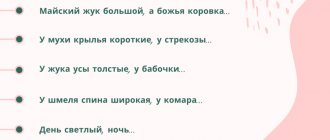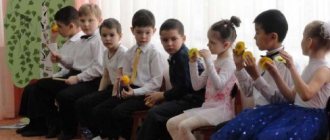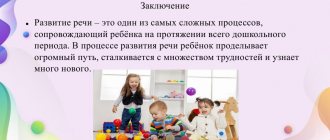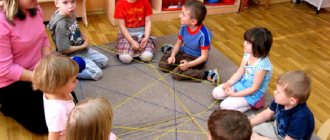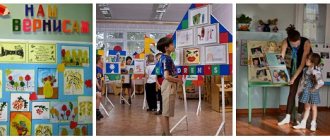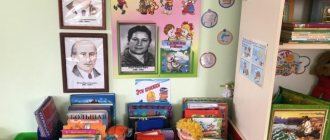Center for Speech Development according to Federal State Educational Standards
The speech development center involves conducting classes individually and in subgroups of 2-3 students. It also becomes one of the centers of children’s independent activity; they are pleased and interested in studying visual materials and playing here.
The goal of creating a center for speech development is the optimal organization of a developmental environment for improving the speech abilities of students.
The tasks of the speech development center directly depend on the age and individual characteristics of the children.
| Children's age | Tasks | |
| 1.5–3 years |
|
|
| 3–4 years |
| |
| 4–5 years |
| |
| 5–6 years |
| |
| 6–7 years |
|
Design of the speech development center
The speech development center is equipped and staffed in accordance with the age of the pupils. Thus, every year it is transformed and enriched to make it interesting and productive for children to study here.
For younger preschoolers, the speech development corner may include a sensory area - a place for the development of fine motor skills. As an option, this is a table with educational games: pyramids, a sorter, books and toys with buttons, bags of seeds and pebbles.
This could be a rug on the wall with buzzers, rubber bands, a plastic mirror, buttons, felt pictures, ribbons, and Velcro. The sensory mat usually depicts the plot of a fairy tale familiar to children (“Turnip”, “Teremok”, “The Three Little Pigs”) or images of natural objects, animals: flowers, trees, butterflies, birds, bunnies, etc. Everyone knows that a child’s first he actually wants to touch the object that interests him, so a developmental rug is made from pieces of bright fabric, scraps of velvet, printed ribbon, and colorful braid.
For all age groups of preschoolers, objects and play sets for the development of speech breathing should be presented in the corner. For these purposes, waste material and simple toys are used: plastic tubes and cups, ping-pong balls, cotton balls, plumes and pinwheels, flags, balloons. The teacher includes breathing exercises in play activities.
In the speech corner of the senior and preparatory groups, a place is set up for board and printed games. The selection is made up of games with letters and words:
- “Entertaining ABC”: for cards with letters (uppercase and printed), you need to select cards with images of objects for these letters. “ABC Lotto”: cards with beeches are filled with chips with animals whose names begin with these letters. “Kaleidoscope of Letters”: children learn to recognize the symbolic designations of letters on the playing field. “Make a word. Dominoes: cards are used to create an image and its name. “Who lives where”: cards with words, animals and their habitats.
To stimulate children's verbal creativity and play dramatization games, a small area with a screen, decorations, and dolls is set up in the corner. Unlike the theatrical activity corner, the space for performances in the speech corner is limited. For example, you can cover a cardboard box - it will be a fairy-tale forest for the figurines. Dialogue using hand puppets and bibabo can be acted out from behind a folding paper screen.
Requirements for the speech development corner according to the Federal State Educational Standard for Preschool Education
Optimal location: the corner is sufficiently lit, located in a quiet place next to the book, theater and sensory development corners.
Compliance with the age and individual needs of children. The presence of an animated character - a doll or toy. The character who owns the corner encourages children to engage in speech activity: he tells funny stories, invites them to play, and asks questions. With the help of an animated toy, motor exercises and articulatory gymnastics are demonstrated. Aesthetics. The corner is designed in the same style as the areas for artistic reading and theatrical activities. The place of study attracts not only with bright colors, but also with interesting objects: reproductions on the wall, figurines on the shelf. Didactic and gaming materials are located in a corner by topic, and students learn to maintain order. Safety. Pupils of the first and second junior groups independently practice the development of fine motor skills under the supervision of a teacher (due to the danger of small parts getting into the respiratory tract). It is not recommended to equip the speech corner with hanging shelves or cabinets with glass doors. Electrical appliances and power supplies must be out of the reach of children. Names of the speech development center
The name of the developmental activity corner in kindergarten should be short and understandable. Traditionally, the activity center is named after the actual focus of the activity. Since a mandatory attribute of a speech corner is an animated toy, the name of this fantasy character is often used in the name. Unusual and funny names arouse additional interest among students. You can arrange a competition for children and parents to come up with a name.
- Classic names: “Speech Corner”, “Speech Coach”, “Speech Development Corner”, “Learning to Talk”, “Speech Development Lessons”.
Titles with the name of the owner of the corner: “Lessons of Aunt Owl”, “Hello, Dunno!”, “Visiting Luntik”, “Button Invites”, “Talker”, “Mushka the Talker”, “Bunny the Lopotushka”.
Funny names: “Let's Talk”, “Gazebo”, “Zvukarik”, “Govoryashka/Govorusha”, “Azbukvarik”, “ABVGDEyka”, “Govorilki”, “Logostrana”, “Let’s Sit and Talk”, “Rechetsvetik”.
Contents of the speech development center
A special place in the speech corner is given to the animated character. The kids talk with this toy or picture in a playful way, he “sends” them parcels with new games and letters with tasks.
For the children's activity center, environmentally friendly (plastic, wooden, upholstered) furniture is selected. Cabinets, chairs and tables should be comfortable and suitable for the height of children. Sample list of furniture for a speech corner:
- Wardrobe/rack with shelves. Table or shelf for temporary exhibitions. Desk and chairs.
Equipment in the speech development corner:
Mirror. To perform articulation exercises, the child needs to monitor his facial expressions, learn to independently control and direct his actions. The mirror should be securely mounted on the wall and located at the work desk, firstly, it is convenient for the child during class, and secondly, this eliminates the risk that children will accidentally touch the mirror and it will fall.
Audio recorder, TV. One of the components of speech development in kindergarten is enriching the auditory experience of pupils. Children hear literate speech, correct pronunciation, and logically constructed statements—their culture of oral communication is formed. For this purpose, audio tales and recordings of artists reading poems are listened to in the speech corner. Watching short videos serves as material for building further conversation.
Magnetic board. As mentioned above, such a board can be used to post current information, display photographs and illustrations on the topic of the lesson. But more often it is used for students to perform exercises. For example, in the following tasks: “Arrange the pictures in the correct sequence to form the plot of a fairy tale. Try to retell it,” “Make words from the letters of the magnetic alphabet...”, “Distribute the pictures by topic, come up with a name for each of them.”
Composition of the material base of the speech development corner
| Visual materials, manuals |
|
| Materials for sensory development |
|
| Items for breathing development |
|
| Didactic materials |
|
| Materials for dramatization games |
|
Speech corner in the junior group according to the Federal State Educational Standard. Speech development corner in the first junior group
Lyudmila Emelyanova
«
Creation of a subject-development environment in a preschool educational institution.
Speech corner
"
Govorush "
The purpose of the speech corner
“
Govorusha ”
of the middle
group is to ensure the timely and effective development of speech as a
means of communication
, cognition, self-expression of the child, and the development of various types of children’s activities.
A severe degree of speech delay speaks when a child speaks. A three-year-old child is at the speech level of a six-month-old child - he can only make equivalent sentences, and his vocabulary is at the level of a six-month-old child. A four-year-old child is at the speech level of a two-year-old child - he formulates simple sentences, the vocabulary is active at the level of a two-year-old child, i.e. uses about 300 words. A five-year-old child is at the speech level of a two-and-a-half-year-old - still simple sentences, vocabulary at the level of a two-and-a-half year old.
- The annual is at the level of a six-month child - a child of only baboons.
- The Biennale is at the level of speech of a one-year-old child - he pronounces a few words.
- A seven-year-old child is at the speech level of a three-year-old child.
According to Spionek, a small degree of speech delay occurs when a two-year-old child's speech is at the developmental level of a child and a half, or when a seven- or six-year-old develops speech in the seventh or sixth year.
The students are greeted by the owner of
“Hare-
Talker ”
corner . It is multifunctional. The children and I inspire him and, on his behalf, ask or answer questions, ask riddles, come up with interesting stories, invite friends to visit, and present unexpected surprises. talking
hare arouses keen interest in children and encourages
speech activity
.
Speech therapists distinguish between two types of speech delay. What do the words “spontaneous” and “non-parasitic” mean? Spontaneous delay in speech development is a normal form of development. This is only a fragmented delay in the development process and is of a transitional nature. The child has good hearing, he understands what he says, and is intellectually effective. He can pronounce almost all syllables in isolation, sometimes also syllables. But he can't put it into words or speak at the right pace. In 25-50% of cases, simple speech delay is hereditary.
Didactic equipment of our corner
corresponds to the structure of
speech disorders in children
, their individual and age characteristics.
When equipping the speech corner,
we focused on providing a richness of sensory sensations and multifunctionality.
The main task of the teacher in this age group is to make the child want to speak.
and express their thoughts, therefore they paid great attention to theatrical activities. Theatrical activity is the basis of each child’s independent creativity, his aesthetic sense, and the development of artistic abilities. During theatrical activities, the child develops play behavior, the ability to be creative in any task, and the ability to communicate with peers and adults.
At about 4-5 years the delay usually levels out, without the need for specialist intervention. Further development of speech continues without distortion or consequences for the future general development of the child. Unintentional delays in language development, in turn, are the result of a disorder rather than a disruption of the developmental process. It demonstrates the presence of clinically significant disorders such as hearing loss, mental retardation, speech impairment, or neurological disorders. May be accompanied by aphasia, dysarthria, dyslonia, stuttering, autism, hearing loss, cerebral palsy.
Theatrical activities play an important role in the development of articulatory gymnastics, speech
intonation expressiveness and facial expressions.
In theatrical activities with children we use different types of theater: tabletop, puppet, finger, glove, and also made with our own hands: theater on silicone blades, theater on plastic eggs, theater from knitted mittens. Every theater needs actors. And then it was decided to make not ordinary dolls, which are made of cardboard with holes for the legs. Our dolls walk, sit and dance. Such dolls develop the imagination and motor skills of pupils. In our fairytale house, new characters appear in the windows every week, based on the theme of the week.
The delay can be either active or passive. Speech develops on a pathological basis, and the observed symptoms of speech impairment develop along with other symptoms of psychomotor developmental disorders. Speech impairments are secondary to severe deafness, mental retardation, cleft palate or speech motor dysfunction, etc. More often than not, they are not the only symptom, but one of many, of developmental disabilities and are part of various symptomatic syndromes.
As a result of unplanned delays in speech development, changes can be temporary or permanent, rapidly changing or deepening. The type, range and potency of the pathogenic agent means that the resulting changes are permanent, meaning that speech in the final stages of development does not reach normal levels and that disturbances may lead to other additional problems such as emotional disturbance, etc. .d. If a friend or other child with whom you interact is not developing in the third year of life, and the baby speaks only simple, easy words, you should suspect delayed speech development and contact a speech therapist immediately!
When selecting didactic material as the basis for filling the speech corner
comprehensive thematic planning on lexical topics was initiated.
A variety of practical material for organizing speech games and activities
:
Manuals for articulatory motor skills (articulation clock, fan, card index of articulatory gymnastics in pictures);
Didactic material promoting the formation of air flow and proper speech breathing
(
“Butterflies”
,
“Blow a snowflake into your mittens”
,
“Windmills”
,
“Gluttonous fruits”
,
“Mysterious sand”
,
“Miracles in a bottle” “What kind of vegetable, what kind of fruit” “We have a vegetable garden”
) made by the hands of adults;
Our children’s favorite aids are games for developing fine motor skills: “Colorful Pebbles”
,
“Laces”
,
“Smart clothespins”
,
“Dry pool”
,
“Massage balls”
, etc. Our children especially like the friends
“Hare-
talkers ”
"Funny little animals - potholders"
For the effectiveness of correctional work with children, a “Flanelegraph”
made from waste material, near which children can play didactic games, study in pairs, and conduct a dialogue based on a fairy tale.
Based on the individual characteristics of the children in our group, we prepared a manual “Funny Sounds”
for the formation and development of phonemic processes, and the game
“Sound Chamomile”
is aimed at developing the sound culture of speech, the ability to clearly and correctly pronounce
a certain sound in words
, and distinguish between hard and soft sounds by ear. We made pencil cases from matchboxes to create a diagram of the words that we use in the evening.
Thematic albums and games for enriching vocabulary, games and manuals for the formation of grammatical structure, as well as coherent speech, didactic material for the development of phonemic hearing and perception.
A selection of printed board games that promote speech development. We created a card index for many areas of activity
. This makes planning easier and helps students work.
Near the speech corner
There is a children's library.
Presented here
favorite children's fairy tales and stories on lexical topics, as well as illustrative material, photographs of children's writers.
Along with fiction, the book corner presents
educational literature and thematic encyclopedias in accordance with the age of children.
Working in kindergarten in this corner
contributes to the development of all aspects
of the speech system
: it enriches vocabulary, children learn to construct statements correctly, retell text, and write descriptive stories.
Publications on the topic:
“Creation of a subject-oriented development environment in the area of children of the senior group.” Type of project: information - design - presentation 1. Preparatory Information - design 2. Basic Practical.
Creation of a developing subject-spatial environment in an early age group “Creation of a developing subject-spatial environment in an early age group.” During early childhood, the child's environment should...
Analytical report “Creating a developing subject-spatial environment in the middle group” Characteristics of the group: the middle group is attended by 23 children, of which 9 are girls and 14 are boys. Group name: "Smeshariki". Educator: Fedoseeva.
Creation of a subject-development environment at the Project site. “Creation of a subject-development environment in the area of children of the senior group.” Head: senior teacher – Chernoraeva L.I.
We live in a steppe area, so in order to introduce the children to various relief objects, I decided to do it on the kindergarten site.
Creation of a subject-development environment for musical development in a preschool educational institution MUNICIPAL PRESCHOOL EDUCATIONAL INSTITUTION KINDERGARTEN No. 274 KRASNOARMEYSKY DISTRICT OF VOLGOGRAD Methodological.
SVETLANA ZAMOTAEVA
Speech corners in groups
One of the tasks of a preschool institution is to prepare children for school.
It has already been proven that the development of a preschool child is greatly influenced by the surrounding space and its occupancy, therefore, great attention should be paid to the equipment in groups of special speech correction corners
.
Such speech corners should be in groups
, they should attract the attention of children, the desire to play, in this designated space.
As has already been tested in practice, when organizing this corner,
the following requirements must be met:
1. A necessary attribute of the speech corner is a mirror
, gaming, didactic, visual material.
2. Didactic equipment must correspond to the structure of children’s speech disorders
, their individual and age characteristics.
3. Based on how full the corner
It is advisable to take into account thematic planning on lexical topics.
3. Visual, didactic material in the speech corner
changes weekly, according to the lexical topic.
4. Speech corner
It is advisable to place it next to the book
corner
.
5. Decorating the corner
should be aesthetically pleasing, attractive to children, and evoke a desire for independent activity.
6. Game material must be accessible to the child.
7. Do not overload the corner with equipment
.
8. An integral attribute of the speech corner
there should be a toy - an “animate character” that helps solve such important correctional tasks as overcoming uncertainty, shyness, achieving emotional stability, self-regulation, arousing children’s
interest in speech
, encouraging
speech activity
.
9. Since our children have visual impairments, their existing speech
the material should take into account the requirements that you discussed at the previous consultation with defectologists.
10. Creating a developmental group
, it is very important that the environment surrounding children is comfortable and aesthetically pleasing.
Beauty shapes a child. Therefore, it is necessary to pay great attention to the aesthetics of the correction corner
.
Its design should be attractive to children and arouse their desire for independent activity. At the same time, it is necessary to teach children to maintain order in the corner
and cultivate a caring attitude towards toys.
Position the correction corner
It is advisable in a well-lit place and somewhat distant from the play area. The proximity of the play area will interfere with activities in
the corner
and distract the child from completing tasks.
This will create more comfortable conditions for studying there. Access to the corner should be convenient
so that children can approach it themselves and study. If there is insufficient lighting, additional lighting must be provided.
Work of a teacher in speech therapy groups
is mainly subordinated to the elimination of speech defects and the development of general qualities and properties of the child’s personality.
To create this corner
you can use a bright multifunctional board - “Goshi’s House - Govorushi”
Decorate the edges of the roof with multi-colored letters of the Alphabet, cut along the contour.
The attic window can be used as a place to place a plot picture (according to the lexical topic)
. Stretch a fishing line across the entire roof onto which you can attach pictures using clips.
Install a mirror in the window of the house, which is covered with a curtain.
Place three boards with pockets for pictures above the window. These boards can be used:
– for placing subject, subject pictures when compiling a story based on a series of pictures.
– when classifying pictures when practicing lexical topics, when differentiating sounds
- when conducting exercises to determine the place of a sound in a word (place pictures on the first board where the sound is at the beginning of the word, on the second - where the sound is in the middle, on the third - where the sound is at the end).
Liven up the log sections with bright yellow circles with pockets, where you can also place pictures and cards. (“Types of articulatory gymnastics exercises, “Facial massage”, “Finger gymnastics”, subject pictures to activate the dictionary on a given lexical topic, pictures with a certain sound).
The pipe is a glued pencil box in which you can place the “Breeze” manual.
To the right and left of the window, two cups are attached using a furniture nail, where plumes, all kinds of blowing toys, signal flags (Vowel-consonant, voiced-voiceless, hard-soft)
.
To make flags, juice tubes are used; the flags themselves are made of colored self-adhesive paper and attached at both ends of the tube: vowel - consonant, respectively, red, blue, green.
To the right and left of the house the wall is covered with peneplain, imitating a fence. Where, accordingly, you can place the magnetic board.
Using the various properties of these objects, it is possible to consolidate the visual image of a letter in children, train their motor skills, develop optical-spatial relationships, and instill an interest in written speech.
All the necessary attributes: magnetic letters, balls of woolen threads from which children construct letters, scissors, crayons, pencils are located here in tea boxes, also covered with colored self-adhesive paper and attached to the wall with double-sided tape.
In front of the house, a toy parrot Gosha - Govorusha sits on a perch.
He is a “friend”, a “partner” of children. His ability to move (with the help of an adult or child, ask questions, make riddles, depict the correct and incorrect pronunciation of sounds arouses keen interest and encourages speech activity
. In front, on the parrot’s belly, there is a pocket where the teacher or speech therapist inserts the next letter being studied, thereby unobtrusively drawing the children’s attention to its image and thereby facilitating its memorization.
In the background of the house you can place the sun, which also not only enlivens the picture, but also has a corrective function. The sun has seven braided rays, and each braid has a bow on it. Bows have a certain color spectrum. The teacher can practice the child in naming primary colors.
Or you can just set aside a place for a speech corner
, which will be a specially equipped space for playing alone or in small
groups
, as well as for individual work.
Its equipment includes: shelving located at different levels, a table, a chair, a large mirror or several small mirrors, gaming, didactic and visual material that stimulates speech activity and verbal communication in children
.
The selection of gaming and didactic material is carried out jointly by the speech therapist and the teacher, which makes their interaction not formal, but very close and fruitful.
Games should be selected in order of increasing complexity, aimed at the development and correction of speech and non-speech
mental processes that make up the psychological basis of speech.
An interesting material for a correction corner
maybe a game guide “
Speech Cube
”,
The manual consists of cubes of different sizes, made of lightweight materials (cardboard, plastic, foam rubber, fabric, polystyrene foam)
.
On each side of the cube there are transparent pockets designed for replaceable speech material
. This material is used when performing articulation exercises to develop children's gross and fine motor skills, lexical and grammatical structure and coherent speech. He changes with the speech therapist and educators as the children master various topics.
Class in the speech therapy corner
The teacher spends the afternoon on the instructions of the speech therapist. Children practice articulation of sounds and automation in words using object pictures. Sentences and short stories are made up with these words.
With a group
For children, a game can be organized to differentiate sounds or expand vocabulary.
Children come to the speech therapy corner
: do gymnastics for the tongue, blow in games to develop an air stream, take outlines, lacing, mosaics, puzzles, name pictures in sound albums, play speech therapist.
One of the main conditions for the quality of speech
influences are the teacher’s sincere interest in his results, the desire to help the child, constant readiness to provide him with the necessary help and support in cases of difficulty. If an adult wants it, a child will want it too.
Filling capacity of the correction corner
should be carried out in the following sections:
speech breathing
, phonemic hearing, articulatory motor skills, sound pronunciation, preparation for literacy, vocabulary and grammar, coherent speech and fine motor skills.
For younger children: mirrors, pictures with descriptions of exercises art. gymnastics, manuals for development. breathing, air flow, fine motor skills (e.g. massage balls, material on onomatopoeia, games and aids for automating sounds, games on vocabulary, grammar, plot pictures (by age)
.
Didactic material in the speech corner
senior and preparatory speech therapy
group
Objectives Didactic aids Didactic games
1. Consolidation of correct speech
exhalation and the formation of the ability to control the strength and duration of the air stream. Pinwheels, pipes, balloons for inflation, bubbles, air stream games, etc.;
"Fish"
;
"Insects"
;
"Transport"
;
"Leaves"
;
"Butterflies"
;
"Magic fluff"
;
"Slide"
;
labyrinths; "Multi-colored meadow"
;
multi-colored balls; sultans; paper snowflakes; pinwheels - pencils; foil bells on a string Storm in a glass”; “Whose boat will get there faster”
;
“Put the ball into the goal”
, etc.
2. Formation of phonemic perception and hearing Noise instruments; sound boxes; children's musical instruments: piano, accordion, drums, pipe, tambourine, rattle, bells, rattles; subject, plot pictures for expressing sounds and their automation; games with paired cards (sounds: R, L; S, 3, C; Sh, Zh, Shch)
;
sounds of vowels and consonants (houses for hard and soft sounds, pictures “stone”
,
“cotton wool”
);
individual aids for sound-letter analysis; word schemes; sound tracks, sound ladder; albums based on the syllabic structure of the word “Collect a bouquet”
;
"In the world of animals and birds"
;
“We divide words into syllables”
;
"Phonematics"
;
"Find yourself a match"
;
“Find what sounds”
;
"Sound Domino"
;
“Guess where the sound is coming from”
;
“Lay out the pictures”
;
“Repeat - make no mistake”
;
"Quiet - loud"
;
"General Sound"
;
“Come up with words with sound”
;
"Broken phone"
;
"Seller and buyer"
;
“Sound symbols”
, etc.
3. Development of articulatory motor skills Object pictures-supports; articulatory structures of the scheme; articulatory gymnastics in albums for a specific sound; diagram of the characteristics of sound articulation; articulatory gymnastics in poetry and pictures; forms of articulatory gymnastics for lips and tongue in symbols; albums with articulation gymnastics (authors T. A. Kulikovskaya, E. A. Pozhilenko)
; circuit for sound characterization; cotton swabs, cotton pads
4. Consolidating the skills of correct sound pronunciation of delivered sounds (in isolation, in syllables, words, in sentences, in connected speech)
“Speech therapy lotto”
,
“Speech therapy domino”
,
“Steam locomotive”
,
“Pick up and name”
, etc.);
Small toys; subject pictures; story pictures; various types of theaters; albums for every sound; speech therapy albums for automating various sounds (authors O. I. Lazarenko, L. A. Komarova)
;
pure sayings, poems, nursery rhymes, tongue twisters; sound characteristics diagram; word scheme; mirrors in the Lotto assortment for sounds C, 3; F, W; R, L; “We speak correctly”
;
"Speech therapy lotto"
;
"Fun Gymnastics"
;
“Sounds, I distinguish you (R, L)
”
5. Consolidating the skills acquired in literacy classes Diagrams of words, sentences, games: “Match the word to the diagram”
,
“Make a sentence according to the diagram”
,
“Add a word”
, crosswords, puzzles.
Magnetic board; sets of magnetic letters; boxes of letters and syllables; Alphabet in Pictures cubes
,
“Learn to read”
,
“Smart cubes”
,
“Syllable cubes”,
etc.;
“Carousel” (learning letters)
;
reading cards; album “Learning Letters”
;
manual "Talking ABC"
;
magic house “Learning to read”
;
“Primer”
by N. S. Zhukov,
“Living ABC”
,
“Reading by syllables”
,
“Native nature”
;
"Journey with Letters"
;
“Reading with Hints”
;
"Texts with tails"
;
“Snow White”
- read with hints;
baby books, etc. Name it, read it, check it”; "Learn to read"
;
“I am learning letters”
;
"Find the letter"
;
“Are you ready for school?”
;
"Syllable Lotto"
;
"Magic Braid"
;
“Find the place of the sound in the word”
;
“Read by first sounds”
;
“Syllabic piggy bank”
, etc.;
"Smart Games"
series , puzzles
6. Activation of vocabulary, general concepts and lexico-grammatical categories Pictures reflecting the lexical topic being studied (plot and subject)
;
educational puzzles, games: lotto, “Pick a Pair”
,
“Who Can Name More”
,
“Part and Whole”
,
“Big and Small”
games “Whose Tail?”
,
“One is many”
,
“Call me affectionately”
,
“What’s missing?”
and etc. ;
"What is made of what"
;
"Weather forecast"
;
"Dress the doll"
;
"In the animal world"
;
"Children's computer"
and others
7. Development of coherent speech Story pictures, “Guess by the description”
,
“When does this happen?”
,
“Playing in the profession”,
etc.;
Series of story pictures “Stories in Pictures”
; different types of theater; pure sayings, poems, nursery rhymes, tongue twisters; library of children's books, etc.
Mnemonic tracks, mnemonic tables, pictograms, etc. Homemade games “Make a story from the pictures”
(
“The Hawk and the Hen”
,
“Two Little Goats”
, etc.)
8. Development of fine motor skills Spinning tops, dry pool, lacing, mosaics, puzzles, stencils for shading, internal and external tracing, pencils,
massage rollers, balls, clothespins, stencils; finger games (memo diagrams on lexical topics)
;
“The world of your fantasies”
(various materials for composing letters: peas, threads of different colors, plasticine, etc.) Shading games;
“Drawing by cells”
; mosaics; lacing games, etc.
Thus, the use of speech corner
allows you to expand
the speech environment in the group
, create in children emotional responsiveness and a desire to participate in
verbal
communication with adults and independently, during the game, easily and naturally develop and improve their
speech skills
.
Work at the speech development center
Classes in the speech corner are built within the framework of the leading activity of preschoolers - play. That is why it is necessary for the teacher to have a toy assistant; inclusion in the play situation occurs as soon as the character greets the children. Children often have to be encouraged to engage in speech activity. The teacher arouses in the pupils interest in conversation, using topics close to the children (“Our toys”, “What do you like to do on a walk”, “What fairy tales did your parents read to you”, “What do you want to become”, etc.).
Games and exercises in the speech development center are aimed at developing abilities and correction. The corner is used during a frontal speech lesson (with the whole group). But more often, individual and subgroup classes are held here, since there is a tendency to reduce speech therapy groups and the teacher is required to carry out continuity with the work of a speech therapist.

